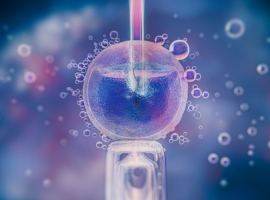Fertility Preservation Options for Cancer Patients
Overview of Fertility Preservation for Cancer Patients
Cancer can be a challenging journey, and for many, the treatments can bring unforeseen consequences, such as infertility. However, advancements in medical science now offer hope through fertility preservation for cancer patients. In this blog, we’ll explore the world of fertility preservation, understanding its importance, when to consider it, available techniques, the process involved, legal and ethical considerations, and future family planning.
Understanding Fertility Preservation
Fertility Preservation is a vital lifeline for cancer patients. It involves freezing reproductive cells, like eggs or sperm, ensuring the potential to have children after cancer treatment. This process acts as a safeguard, offering hope and options for future family planning. By understanding these methods, individuals facing cancer can make informed decisions, paving the way for a possible journey to parenthood once their health is restored.
Importance of Fertility Preservation for Cancer Patients
The impact of cancer treatments on fertility can be significant. Radiation, chemotherapy, and surgery may affect reproductive organs, making it challenging to conceive naturally after treatment. Fertility preservation allows patients to maintain the option of starting a family when they are ready, post-cancer.
When to Consider Fertility Preservation
Considering fertility preservation should be part of the initial discussions when a cancer diagnosis is made. It’s essential to act swiftly, as certain treatments may compromise fertility. Both men and women should explore options before starting cancer therapies, ensuring they make informed decisions about their reproductive future.
Available Fertility Preservation Techniques
Fertility preservation helps people save the chance to have kids later. Women freeze eggs, men freeze sperm, and some store a piece of their ovary. This is useful before medical treatments or for those waiting to start a family. Storing these reproductive cells or tissues increases the chance of having biological children later. Talking to a fertility specialist at the best IVF center in Mumbai helps understand and choose the best preservation method based on individual needs and plans.
Egg Freezing (Oocyte Cryopreservation)
Egg freezing and sperm banking for cancer patients, or oocyte cryopreservation, is a modern fertility solution. It includes collecting a woman’s eggs, freezing them, and storing for later use. This technique allows women to delay having children until they’re ready, whether for career pursuits or health considerations. It’s especially helpful for those undergoing cancer treatments at our best IVF hospital in Mumbai or other situations affecting fertility, offering a way to safeguard the possibility of future parenthood. Egg freezing provides flexibility, empowering women to make family planning decisions in alignment with their life circumstances.
Sperm Freezing (Sperm Cryopreservation)
Sperm freezing, also known as sperm Cryopreservation options for cancer treatment, is an essential part of preserving fertility. It includes collecting and freezing a man’s sperm for later use. This method is particularly valuable for individuals dealing with health issues like cancer that may affect fertility. Sperm freezing ensures that healthy sperm is available when needed, offering a practical way to plan for a family in the future. It’s a simple yet powerful solution to safeguard reproductive options and achieve the dream of parenthood when the time is right.
Embryo Freezing
Embryo freezing is a method where eggs and sperm join outside the body, forming embryos that are then frozen for later use. This process is often chosen by couples aiming to preserve their fertility. It allows them to store embryos until they are ready to start a family, providing flexibility in family planning. Embryo freezing is a helpful option for those facing medical treatments that may affect fertility, ensuring the opportunity to have biological children when the time is right.
Ovarian Tissue Freezing (Ovarian Cortex Cryopreservation)
Ovarian tissue freezing, or ovarian tissue cryopreservation for fertility preservation involves taking a small piece of a woman’s ovarian tissue, freezing it, and storing it for the future. This method is especially relevant for girls or women who can’t use traditional fertility preservation methods. By freezing a piece of the ovaries, it holds the potential to restore fertility after cancer treatment. Ovarian tissue freezing provides an option for preserving reproductive possibilities and the hope of having biological children down the road.
Fertility Preservation Process
Fertility preservation is like making a plan for having a family in the future. You talk to a specialist at our IVF center in Mumbai, get some medicine if needed, and then they collect and freeze your eggs or sperm. These frozen cells are stored until you’re ready to use them. This process helps protect your ability to have kids, giving hope for starting a family later, especially after facing health challenges. It’s a thoughtful way to keep the dream of parenthood alive, even when dealing with tough times.
Initial Consultation and Planning
The first step in saving your fertility is talking to a specialist to make a personalized plan. This includes discussing your hormonal suppression in cancer treatment and what cancer treatment you’ll have. The specialist helps you understand the options available for keeping the chance to have a family in the future. It’s a crucial step where you and the specialist work together to decide the best path for protecting your fertility before starting any treatment.
Ovarian Stimulation
Ovarian stimulation is a process that gives a little boost to the ovaries. With the help of fertility medications, the ovaries are encouraged to produce more eggs than usual. This step is often part of fertility preservation methods like egg freezing. By stimulating the ovaries, it increases the chances of collecting multiple eggs during the retrieval process, offering more options for future use. It’s a simple yet important step to enhance the success of fertility preservation and provide individuals with greater flexibility in family planning.
Egg or Sperm Retrieval
Egg or sperm retrieval is the next step in fertility preservation. After ovarian stimulation, a simple procedure is done to collect eggs or sperm. For egg retrieval, a thin needle is used to get the eggs from the ovaries. In the case of sperm, it’s collected through a straightforward process. This step is usually outpatient, meaning it doesn’t require a hospital stay. The collected eggs or sperm are then processed and frozen, ready to be stored until the individual is ready to use them for future family planning.
Freezing and Storage
After getting eggs or sperm, the next step is freezing and storage. This means carefully keeping them in very cold conditions so they stay healthy. Special places look after them until you’re ready to use them. It’s like pressing pause on your ability to have kids until you’re ready. When the time is right, these frozen cells can be used to start a family through methods like in vitro fertilization (IVF). It’s a way to plan for the future and have flexibility in deciding when to become a parent.
Legal and Ethical Considerations
Legal and ethical considerations are like the important rules and moral thinking when it comes to fertility preservation. Before starting, you need to agree to everything through informed consent, making sure you understand what might happen. It’s also crucial to decide what should be done with the stored cells in different situations, like if someone passes away or if plans change. These decisions help make sure that using the preserved cells follows the rules and respects everyone involved. Thinking about these legal and ethical aspects is a big part of the fertility preservation process.
Informed Consent
Informed consent means agreeing to fertility preservation with full understanding. Before starting, you say “okay” after knowing all the details. It ensures everyone is clear about what happens, especially with stored cells in different situations. This way, the process follows rules and respects choices. It’s a simple way of making sure everyone involved knows and agrees with what’s happening, creating a clear and respectful path in the fertility preservation journey.
Future Use and Disposition
Future use and disposition mean deciding what happens later with stored cells. It’s about making choices on how to handle them, especially in different situations like passing away or changing plans. This ensures a clear plan for the stored cells, respecting personal wishes and following the rules. It’s like planning ahead, making sure the use and handling of preserved cells align with agreed-upon decisions and regulations, creating a thoughtful approach to the future use and disposition of stored reproductive material.
Future Family Planning
After preserving fertility, there are various options for building a family later on. In vitro fertilization (IVF) is one way, where eggs and sperm are combined outside the body, and resulting embryos are placed in the uterus. Surrogacy is an option if carrying a pregnancy isn’t possible. Adoption is a beautiful choice too. Future family planning allows individuals to explore different paths, ensuring they have options to create the family they envision when the time is right.
In Vitro Fertilization (IVF)
In vitro fertilization (IVF) is like a special way of helping people have a baby. It involves combining eggs and sperm outside the body in a lab. Once the embryos form, they are placed into the uterus. IVF is often used when natural conception is challenging. It’s a way to increase the chances of getting pregnant, offering hope to those facing fertility issues. IVF provides an assisted method for starting a family, giving individuals or couples the opportunity to fulfill their dream of parenthood.
Surrogacy
Surrogacy is when someone else carries the baby for you. It’s a wonderful option for those who can’t carry a pregnancy. In surrogacy, the fertilized embryo is placed in the surrogate’s uterus to grow and develop. This allows individuals or couples to have a biological connection with their child, even if they can’t carry the pregnancy themselves. Surrogacy provides an alternative and heartwarming way to bring a child into the world, offering a pathway to parenthood for those facing challenges with pregnancy.
Adoption
Adoption is a wonderful way to become a family. It means legally becoming the parent of a child who is not biologically yours. People choose adoption for different reasons, like being unable to have children or wanting to give a loving home to a child who needs one. The process involves checks and legal steps to make sure the parents and child are a good match. Adoption is a way to create a family through love and care, providing a home for a child who becomes an important part of their lives.
Get more insights in our latest blog post: When to Seek Help for Infertility
Fertility preservation for cancer patients opens doors to a future where starting a family is not just a dream but a tangible possibility. Understanding the available options, the process involved, and the legal and ethical considerations is crucial for making informed decisions. As medical science continues to advance, the journey towards preserving fertility becomes more accessible, offering hope and optimism to those facing the challenges of cancer. If you or a loved one is navigating this path, consult with a fertility specialist at our best IVF center in Mumbai, to explore the personalized options available on your journey to parenthood.





There are no comments